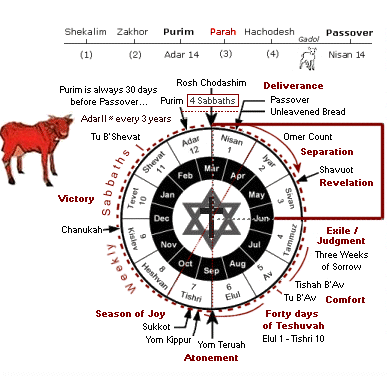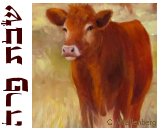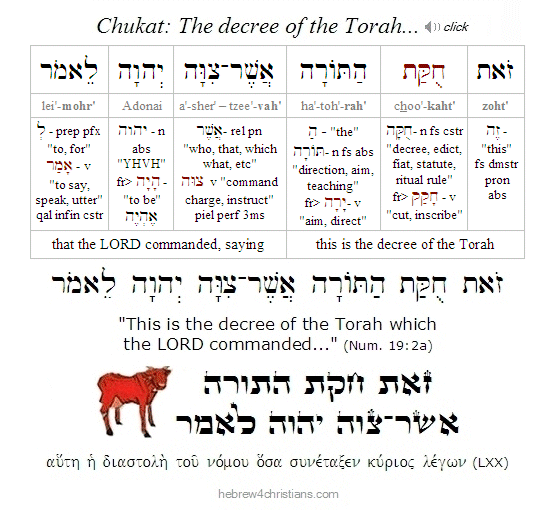|
The Sabbath that immediately follows Purim is called Shabbat Parah - the "Sabbath of the Cow," when the chapter of the parah adumah (ЧӨЦёЧЁЦёЧ” ЧҗЦІЧ“Ц»ЧһЦјЦёЧ”), or the "Red Heifer," is read following the regular Torah service (i.e., Num. 19:1-22). The early sages chose this reading for this time of the year because Jews were required to purify themselves before coming to Jerusalem for the pilgrimage festival of Passover.
The Red Heifer offering is considered a paradox to most Jewish thinkers, since the one who offers the sacrifice becomes unclean, while the sprinkling of the ashes of the sacrifice makes people clean... The ritual is considered "chok" (Ч—Ч§) within the Jewish tradition, meaning that it makes no rational sense. In fact, the Talmud states that of all the taryag mitzvot (613 commandments), this is the only one that King Solomon could not fathom, since this sacrifice was regarded as the most paradoxical of all the sacrifices found in the Torah.
The parah adumah had to be a perfect specimen that was completely red, "without blemish, in which there is no defect (mum)." The rabbis interpreted "without blemish" as referring to the color, that is, without having so much as a single white or black hair. This is the only sacrifice in the Torah where the color of the animal is explicitly required. Moreover, the parah adumah was never to have had a yoke upon it, meaning that it must never have been used for any profane purposes.
Unlike all other sacrifices offered at the mizbeach (altar at the Mishkan), the parah adumah was taken outside the camp and there slaughtered before the priest (in this case, Elazar, Aaron's son), who then took some of its blood and sprinkled it seven times before the Mishkan (thereby designating it as a purification offering). [During the Second Temple period, the High Priest performed this ceremony facing the Temple while atop the Mount of Olives.] Then the red heifer would be burned in its entirety: its hide, flesh, blood, and even dung were to be burned (unlike other Levitical korbanot). Unlike other offerings, all the blood of the sacrifice was to be burned in the fire.
Hyssop, scarlet yarn, and a cedar stick would then be thrown upon the burning parah adumah (interestingly, these same items were used to cleanse from sin or tzara'at (skin disease). The blood was assimilated into the ashes of the sacrifice, which were then gathered and mixed with water to create the "water of separation" (mei niddah) for the Israelite community. Note that the word "separation" (niddah) refers to menstrual impurity and harkens to Zechariah 13:1: "On that day there shall be a fountain opened for the house of David and the inhabitants of Jerusalem, to cleanse them from sin and from niddah."
Anyone (or anything) that came into contact with a corpse (the embodiment of sin and death) was required to be purified using the mei niddah. The purification procedure took seven days, using stalks of hyssop dipped into the water and shaken over the ritually defiled person on the third day and then again on the seventh day. After the second sprinkling, the person undergoing the purification process would be immersed in a mikvah and then be unclean until the following evening.
The Uniqueness of the Sacrifice
The Parah Adumah sacrifice was entirely unique, for the following reasons:
- It was the only sacrifice that specifically required an animal of a particular color. This animal was extremely rare and unique of its kind (in fact, Maimonides wrote, "Nine Parot Adumot were prepared from the time the Commandment was given until the destruction of the Second Temple. Moses our Teacher prepared one, Ezra prepared one and seven more were prepared until the Destruction of the Temple. The tenth will prepared by the Mashiach." (We would say "was prepared" by the Mashiach Yeshua, blessed be He.)
- It was the only sacrifice where all the rituals were carried out outside of the camp (and later, outside the Temple precincts). That is, the "blood applications" of this sacrifice occurred in a location apart from the altar (the Talmud recounts that the High Priest performed the blood applications of the Red Heifer while gazing at the Temple and at the Holy of Holies from a mountain opposite the Temple mount).
- It was the only sacrifice where the ashes were preserved and used (other sacrifices required the ashes be disposed outside of the camp).
- Hyssop, scarlet yarn, and a cedar stick would then be thrown upon the burning parah adumah (these same items were used to cleanse from tzara'at, skin disease). In other words, the blood was assimilated into the ashes of the sacrifice, which were then gathered and mixed with water to create the "water of separation" (mei niddah) for the Israelite community. Note that the word "separation" (niddah) refers to menstrual impurity and harkens to Zech. 13:1: "On that day there shall be a fountain opened for the house of David and the inhabitants of Jerusalem, to cleanse them from sin and from niddah."
- It was the only sacrifice that ritually contaminated the priest who offered it, but made the one who was sprinkled by it clean.
According to Jewish tradition, this sacrifice was to atone for the sin of the Golden Calf, though the Torah itself does not make this association. The LORD Yeshua, our Mashiach, is the perfect fulfillment of the Parah Adumah, since He was completely without sin or defect (2 Cor. 5:21; John 8:46); He was sacrificed outside the camp (Heb. 13:13); He made Himself sin for us (2 Cor. 5:21); His sprinkling makes us clean (1 Pet. 1:2; Heb. 12:24; Rev. 1:5); and the "water of separation" that His sacrifice created is the means by which we are made clean from the impurity of sin (Eph. 5:25-6; Heb. 10:22).
Hebrew Lesson
Num. 19:2a Hebrew (click):
The Haftarah for Shabbat Parah
The Haftarah read for Shabbat Parah (Ezek. 36:16-38) is ostensibly linked to the sacrifice of the Red Heifer, though on a deeper level it relates to Israel's national salvation and return to the land after the Great Tribulation period.... Despite the horrors of the worldwide Diaspora of the Jewish people and their faithlessness before the nations, God will be true to His word (see references, below) by causing the Jews to finally accept His salvation (i.e., Yeshua) and to return to the land of Israel. At that time, "all Israel will be saved," as the Apostle Paul also foretold (Rom. 11:26):
Therefore say to the house of Israel, 'Thus says the Lord GOD (ЧҗЦІЧ“Ч ЦёЧҷ ЧҷЧ”Ч•Ч”): It is not for your sake, O house of Israel (Ч‘ЦјЦөЧҷЧӘЦҫЧҷЦҙЧ©ЧӮЦ°ЧЁЦёЧҗЦөЧң), that I am about to act, but for the sake of my holy Name (ЧңЦ°Ч©ЧҒЦөЧқЦҫЧ§ЦёЧ“Ц°Ч©ЧҒЦҙЧҷ) which you have profaned among the nations to which you came. I will sanctify my great Name (Ч§ЦҙЧ“ЦјЦ·Ч©ЧҒЦ°ЧӘЦјЦҙЧҷ ЧҗЦ¶ЧӘЦҫЧ©ЧҒЦ°ЧһЦҙЧҷ Ч”Ц·Ч’ЦјЦёЧ“Ч•Ц№Чң) which has been profaned among the nations, and which you have profaned among them. And the nations will know that I am the LORD,' declares the Lord GOD, 'when through you I vindicate my holiness before their eyes. I will take you from the nations and gather you from all the countries and bring you into your own land. I will sprinkle clean water (i.e., mayim tehorim: ЧһЦ·ЧҷЦҙЧқ ЧҳЦ°Ч”Ч•Ц№ЧЁЦҙЧҷЧқ) on you, and you shall be clean from all your uncleannesses, and from all your idols I will cleanse you. And I will give you a new heart (i.e., lev chadash: ЧңЦөЧ‘ Ч—ЦёЧ“ЦёЧ©ЧҒ), and a new spirit (i.e., ruach chadashah: ЧЁЧ•ЦјЧ—Ц· Ч—ЦІЧ“ЦёЧ©ЧҒЦёЧ”) I will put within you. And I will remove the heart of stone (i.e., lev ha'even: ЧңЦөЧ‘ Ч”ЦёЧҗЦ¶Ч‘Ц¶Чҹ) from your flesh and give you a heart of flesh (i.e., lev basar: ЧңЦөЧ‘ Ч‘ЦјЦёЧ©ЧӮЦёЧЁ). I will put my Spirit (i.e., ruchi: ЧЁЧ•ЦјЧ—ЦҙЧҷ) within you, and cause you to walk in my statutes (i.e., chukkim: Ч—Ц»Ч§ЦјЦҙЧҷЧқ) and be careful to obey my rules (i.e., mishpatim: ЧһЦҙЧ©ЧҒЦ°ЧӨЦјЦёЧҳЦҙЧҷЧқ). You shall dwell in the land that I gave to your fathers, and you shall be my people, and I will be your God. I will save you (Ч•Ц°Ч”Ч•Ц№Ч©ЧҒЦ·ЧўЦ°ЧӘЦјЦҙЧҷ) from all your uncleanness (i.e., tumah: ЧҳЦ»ЧһЦ°ЧҗЦёЧ”)... (Ezek. 36:22-29)
Despite the various rebukes given by the Hebrew prophets regarding Israel's disobedience -- including the repeated warning of exile from the land -- the prophets never abandoned Moses' original prophecies (Deut. 28:64, 30:3-5) that Israel would one day be fully restored in the land promised to the descendants of Abraham (e.g., Isa. 11:1-9; 12:1-3; 27:12-13; 35:1-10; 43:1-8; 60:18-21; 66:20-22; Jer. 16:14-16; 30:10-18; 31:31-37; 32:37-40; Ezek. 11:17-21; 28:25-26; 34:11-16; 37:21-25; 39:25-29; Hosea 1:10-11; 3:4-5; Joel 3:17-21; Amos 9:11-15; Micah 4:4-7; Zeph. 3: 14-20; Zech. 8:4-8; 10:11-15). Note especially that the prophet Zechariah, in the years following the return from the Babylonian captivity, speaks of a future restoration to the land (Zech. 10:8-12). This most likely refers to the regathering that will follow Yom Adonai, the great Day of the LORD, after the Great Tribulation period, when Yeshua returns to establish His kingdom in Jerusalem at the start of the Millennium.
But what about the present regathering of Israel into the land? In Isaiah 11:11-12:6, a "second" (and worldwide) regathering of Israel is mentioned, but it begs the question of when the first regathering took place. Some have suggested this was the return from the Babylonian Exile (c. 536 BC), though this is unlikely since this was essentially a migration from one country (Babylonia) to another (Judea). As Arnold Fructenbaum has written, "The Bible does not allow for several worldwide regatherings in unbelief; it allows for one worldwide regathering in unbelief; followed by the last one, the one in faith, which is the second one. This text (i.e., Isaiah 11:11-12:6) only permits two worldwide regatherings from the four corners of the earth. Therefore, the present Jewish State is very relevant to Bible prophecy (Fruchtenbaum, Footsteps of the Messiah, p. 102).
As Yeshua clearly taught (e.g., Matt. 24), Israel must both be regathered to her land and functioning as a nation before the Second Coming takes place. When the modern State of Israel was born in 1948, the stage was set for the beginning of the prophesied acharit ha-yamim (ЧҗЦ·Ч—ЦІЧЁЦҙЧҷЧӘ Ч”Ц·ЧҷЦјЦёЧһЦҙЧҷЧқ), the "End of Days."
 |
Related Topics:
|



